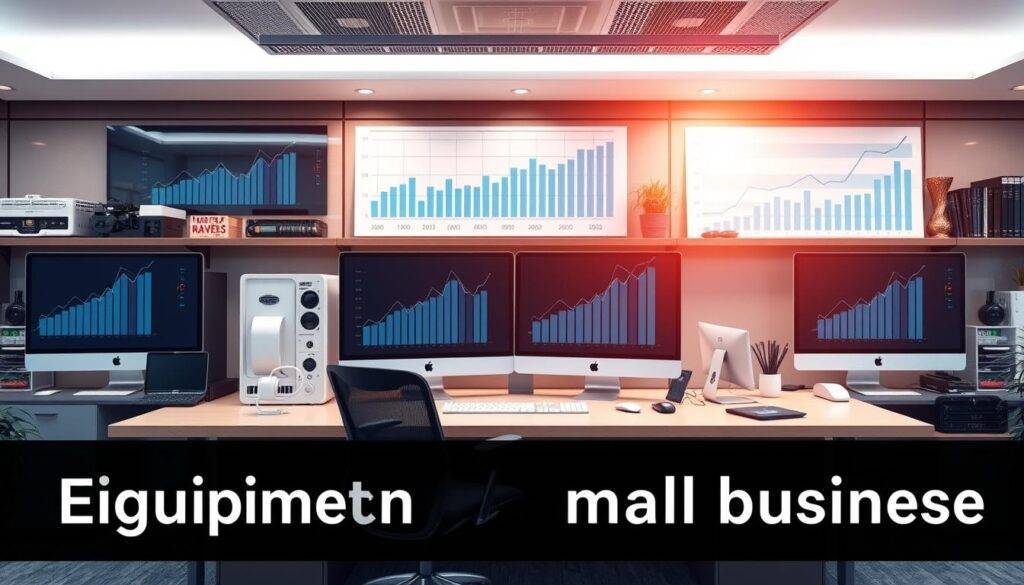Small business owners often struggle to get the equipment they need. This includes everything from special machines to office gear. These items can be very expensive, leading many to look for financing options. Equipment financing is a smart choice that’s key to business success today.
This guide explores equipment financing and why it’s so important for small businesses. It covers the different ways to finance equipment. Whether you want to grow your business, update your tech, or get new tools, knowing about equipment financing can help a lot.
Key Takeaways
- Equipment financing is a vital tool for small businesses to acquire necessary assets and drive growth.
- Exploring the various financing solutions, from traditional loans to alternative options, can help businesses make informed decisions.
- Understanding the benefits, terms, and requirements of equipment financing is crucial for successful implementation.
- Comparing equipment financing and leasing can help businesses choose the best option for their unique needs and financial goals.
- Integrating equipment financing with other funding sources, such as merchant cash advances, can create a comprehensive financial strategy.
What is Equipment Financing? Here’s What Small Business Owners Need to Know!
As a small business owner, having the right equipment is key. But buying it can be expensive. Equipment financing can change the game for your business.
Types of Equipment Financing Solutions
Equipment financing comes in different forms:
- Equipment loans: These are traditional term loans for new or used equipment.
- Equipment leases: You can rent equipment for a set time, with the option to buy it later.
- Equipment financing agreements: These flexible options let you pay for equipment over time, with custom terms.
Key Benefits for Business Growth
Financing equipment offers many benefits for your business:
- Improved cash flow: It spreads the cost of equipment over time, freeing up money for other investments.
- Tax advantages: Often, equipment financing payments are tax-deductible, saving you money.
- Faster upgrades: Leasing or financing makes it easier to update or replace old technology, keeping you competitive.
Common Equipment Financing Terms
When looking at equipment financing, know these common terms:
- Loan term: The time you have to repay the financing, usually 1 to 7 years.
- Interest rate: The cost of borrowing, shown as a percentage of the principal.
- Down payment: The upfront money you pay, often 10% to 30% of the total cost.
Knowing these key points will help you make smart choices and get the best terms for your business.
| Financing Option | Advantages | Disadvantages |
|---|---|---|
| Equipment Loan |
|
|
| Equipment Lease |
|
|
“Equipment financing is a strategic tool that can help small businesses unlock their full growth potential by providing access to the necessary tools and technology.”
The Importance of Equipment Financing in Modern Business Operations
In today’s fast world, equipment financing is key for small and medium businesses. It helps them stay ahead, work better, and keep up with new tech. With capital funding funds and merchant cash advance services, they can buy the equipment they need. This way, they don’t use up all their money.
One big plus of equipment financing is it helps keep money flowing. Instead of spending a lot on equipment at once, businesses can pay over time. This keeps their cash flow strong, which is vital for everyday work, growing, and unexpected costs.
Also, equipment financing lets businesses quickly get new tech and update their gear. This keeps them competitive and efficient. By keeping up with tech, they can offer better products and services. This helps them stay ahead and succeed in the long run.
| Key Benefits of Equipment Financing | Comparison |
|---|---|
|
|
In today’s world, being quick and flexible is crucial for success. Equipment financing is a strong tool for all kinds of businesses. It helps them get the money they need for the equipment that powers their work. This sets them up for growth and profit in the future.
“Equipment financing allows us to stay at the forefront of our industry, ensuring our operations are efficient, productive, and able to meet the evolving needs of our customers.”
Qualifying for Equipment Financing: Requirements and Criteria
To get equipment financing for your small business, you need to meet certain criteria. Knowing these requirements can help you get ready. This way, you’ll have a better chance of getting the funding you need.
Credit Score Requirements
Lenders look at your business’s credit score first. They usually want a score of 600 or higher. This shows you’re creditworthy and they see less risk in lending to you.
If your score is lower, don’t worry. Look into merchant cash advance direct lenders or capital fund lenders. They might have more flexible rules.
Business History Documentation
Lenders also check your business’s history. You’ll need to show:
- Business registration and licenses
- Previous tax returns and financial statements
- Bank statements showing steady cash flow
- Invoices or contracts with clients
Financial Statement Preparation
Lenders will also look at your financial statements. Make sure your balance sheet, income statement, and cash flow statement are current. They should show your company’s financial health well.
Knowing what equipment financing requires can help your small business succeed. If you don’t fit traditional lender criteria, consider merchant cash advance direct lenders or capital fund lenders. They might offer more flexibility.
Traditional vs Alternative Equipment Financing Options
Small business owners have many ways to fund their equipment needs. Traditional financing from banks is common. But, merchant cash advance companies and capital funding services offer new paths that might fit modern businesses better.
Traditional financing means getting a loan or lease from a bank. It needs lots of paperwork, a long wait, and good credit. It’s not flexible for businesses that change or have uneven cash flow.
- Advantages of traditional equipment financing:
- Lower interest rates
- Longer repayment terms
- Potential tax benefits
- Disadvantages of traditional equipment financing:
- Lengthy approval process
- Strict credit requirements
- Limited flexibility in repayment schedules
Alternative financing options from merchant cash advance companies are different. They are quicker, more flexible, and focus on your business’s potential, not just credit.

“Alternative financing can be a game-changer for small businesses that need to acquire equipment quickly and efficiently without getting bogged down in the traditional lending process.”
Alternative financing might cost more. But, it’s more accessible and quick. This is great for businesses that want to grow fast and stay competitive.
Choosing between traditional and alternative financing depends on your business. Think about what you need and what will help you succeed. This way, you can make a choice that fits your goals and helps your business grow.
Understanding Equipment Financing Rates and Terms
When looking at merchant cash advance business or small business cash advance, it’s key to know about equipment financing rates and terms. This info helps business owners make smart choices and avoid surprises.
Interest Rate Structures
Equipment financing interest rates can change a lot. They depend on the lender, the equipment, and the business’s credit. Here are some common types:
- Fixed interest rates: Stay the same for the whole loan
- Variable interest rates: Change with the market, like the prime rate
- Tiered interest rates: Go down as you pay off the loan
Repayment Options and Schedules
Businesses have many ways to pay back equipment loans. Here are a few:
- Monthly installments: Regular, fixed payments over time
- Seasonal payments: Payments that match your cash flow
- Deferred payments: Start paying later, after using the equipment
Hidden Fees and Charges
It’s vital to read the fine print for equipment financing. Look out for extra fees like:
| Fee Type | Description |
|---|---|
| Origination fees | Charges for applying for the loan |
| Prepayment penalties | Fees for paying off early |
| Late payment fees | Penalties for missing payments |
Knowing about equipment financing rates and terms helps business owners. They can make better choices for their merchant cash advance business or small business cash advance.
Equipment Leasing vs Equipment Financing: Making the Right Choice
When you need equipment for your small business, you have two main choices: leasing or financing. Each has its own benefits. The best choice depends on your business needs, budget, and goals. Let’s look at the main differences to help you decide.
Ownership and Asset Control
Equipment leasing lets you “rent” equipment. At lease end, you can return it, extend, or buy it for a set price. Equipment financing means you own it outright. This gives you more control and lets you build equity over time.
Tax Benefits and Accounting
Leasing might be better for taxes since lease payments are tax-deductible. Financing lets you depreciate the asset, which can help with capital funds. Think about how each affects your accounting.
Flexibility and Upgrade Potential
Leasing offers more flexibility. You can easily upgrade or swap equipment during the lease. This is great for fast-changing industries. Financing gives you long-term ownership and control.
The choice between leasing and financing depends on your business’s needs and goals. Talk to a financial advisor or merchant cash advance services provider. They can help you find the best option for your small business.

How Merchant Cash Advances Complement Equipment Financing
Small business owners know that using different funding sources is smart. Merchant cash advances and equipment financing work well together. This mix can open new doors and help businesses grow.
Combining Funding Sources
Merchant cash advances and equipment financing do different things but can help each other. Equipment financing gets you the tools you need. A merchant cash advance gives you quick money for things like stock, ads, or emergencies.
Using both can help businesses get the right equipment and stay flexible. This way, they can handle changes or new chances.
Strategic Financial Planning
Putting merchant cash advances and equipment financing together needs careful thought. Business owners must look at their money flow, goals, and how much risk they can take. This helps find the best mix of funding.
- Check what equipment you really need
- Look at the costs of equipment loans
- Figure out when and how much to get from a merchant cash advance
- Plan how to pay back in a way that works for your business
Aligning these funds with your business plan can help you reach your full potential. It sets you up for success in the long run.
| Funding Source | Key Benefits | Typical Use Cases |
|---|---|---|
| Equipment Financing |
|
|
| Merchant Cash Advance |
|
|
By smartly mixing merchant cash advances and equipment financing, small businesses can build a strong financial base. This supports their growth and success.
Equipment Financing Application Process and Timeline
Getting equipment financing can seem hard, but it’s easier with the right steps. First, make sure you have all needed documents. This includes financial statements, business licenses, and details about the equipment you want.
Required Documentation
Before you apply, collect your business’s financial records. You’ll need income statements, balance sheets, and cash flow statements. Also, have info on the equipment, like make, model, and cost. Some lenders might ask for personal financial statements or tax returns too.
Application Steps
After you have all your documents, the application process is simple. Look for the best offers from different lenders. Then, fill out the application online, by phone, or in person.
Approval Timeframes
How long it takes to get approved varies. You might hear back in a few days or weeks. The lender will check your financials and credit to find the right financing for you.





